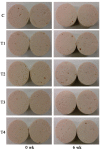Effect of Thyme and Rosemary on The Quality Characteristics, Shelf-life, and Residual Nitrite Content of Sausages During Cold Storage
- PMID: 27857542
- PMCID: PMC5112429
- DOI: 10.5851/kosfa.2016.36.5.656
Effect of Thyme and Rosemary on The Quality Characteristics, Shelf-life, and Residual Nitrite Content of Sausages During Cold Storage
Abstract
The effects of thyme and rosemary on the quality characteristics of sausages during cold storage were investigated. Sausages were prepared with thyme and rosemary powder (1 and 2%) and stored for 6 weeks at 10℃. The pH was significantly decreased in sausages by addition of thyme and rosemary compared to that observed in the control before and after storage. At 4 weeks of storage, the residual nitrite content was decreased by thyme and rosemary compared to the control. Lightness (L*) and yellowness (b*) were increased during storage, whereas redness (a*) and whiteness (W) were decreased before and after storage by addition of thyme and rosemary. The amount of TPC and lactic acid bacteria was lower at the end of storage in sausage containing thyme and rosemary. The 2, 2-diphenyl-1-picryl-hydrazyl-hydrate (DPPH) radical scavenging capacity of sausages was increased by addition of thyme and rosemary compared to that in the control before and after storage. In particular, T2 (0.2% thyme addition) showed the highest DPPH radical scavenging capacity during storage. In a sensory evaluation, flavor and overall acceptability were lower in sausages containing thyme and rosemary than in the control. However, at the end of storage (6 wk), aroma, flavor and overall acceptability were not significantly different among the sausage samples.
Keywords: lipid oxidation; residual nitrite; rosemary; sausage; thyme.
Figures
Similar articles
-
Effect of the Addition of Schisandra chinensis Powder on the Physico-chemical Characteristics of Sausage.Asian-Australas J Anim Sci. 2013 Dec;26(12):1753-61. doi: 10.5713/ajas.2013.13194. Asian-Australas J Anim Sci. 2013. PMID: 25049766 Free PMC article.
-
Effect of Gaeddongssuk (Artemisia annua L.) Powder on Quality and Shelf Stability of Emulsion Sausages during Refrigerated Storage.Korean J Food Sci Anim Resour. 2016 Oct 31;36(5):601-611. doi: 10.5851/kosfa.2016.36.5.601. Korean J Food Sci Anim Resour. 2016. PMID: 27857535 Free PMC article.
-
Development of Sausages Containing Mechanically Deboned Chicken Meat Hydrolysates.J Food Sci. 2015 Jul;80(7):S1563-7. doi: 10.1111/1750-3841.12920. Epub 2015 Jun 16. J Food Sci. 2015. PMID: 26077386
-
The Effect of Plasma-Activated Water Combined with Rosemary Extract (Rosmarinus officinalis L.) on the Physicochemical Properties of Frankfurter Sausage during Storage.Foods. 2023 Nov 3;12(21):4022. doi: 10.3390/foods12214022. Foods. 2023. PMID: 37959142 Free PMC article.
-
Effects on quality properties of cooked pork sausages with Caesalpinia sappan L. extract during cold storage.J Food Sci Technol. 2019 Nov;56(11):4946-4955. doi: 10.1007/s13197-019-03965-6. Epub 2019 Aug 1. J Food Sci Technol. 2019. PMID: 31741518 Free PMC article.
Cited by
-
Effects of Different Marination Conditions on Quality, Microbiological Properties, and Sensory Characteristics of Pork Ham Cooked by the Sous-vide Method.Korean J Food Sci Anim Resour. 2018 Jul;38(3):506-514. doi: 10.5851/kosfa.2018.38.3.506. Epub 2018 Jul 31. Korean J Food Sci Anim Resour. 2018. PMID: 30018495 Free PMC article.
-
Effect of Cacao Nip Extracts (CEs) on Quality Characteristics of Pork Patties during Cold Storage Period.Food Sci Anim Resour. 2019 Dec;39(6):918-933. doi: 10.5851/kosfa.2019.e77. Epub 2019 Dec 31. Food Sci Anim Resour. 2019. PMID: 31950108 Free PMC article.
-
Use of Green Tea Extract and Rosemary Extract in Naturally Cured Pork Sausages with White Kimchi Powder.Food Sci Anim Resour. 2021 Sep;41(5):840-854. doi: 10.5851/kosfa.2021.e41. Epub 2021 Sep 1. Food Sci Anim Resour. 2021. PMID: 34632403 Free PMC article.
-
Effects of Lemon Extract Powder and Vinegar Powder on the Quality Properties of Naturally Cured Sausages with White Kimchi Powder.Food Sci Anim Resour. 2021 Nov;41(6):950-966. doi: 10.5851/kosfa.2021.e48. Epub 2021 Nov 1. Food Sci Anim Resour. 2021. PMID: 34796323 Free PMC article.
References
-
- Akowuah G. A., Ismail Z., Norhayati I., Sadikun A. The effects of different extraction solvents of varying polarities of polyphenols of Orthosiphon stamineus and evaluation of the free radical-scavenging activity. Food Chem. 2005;93:311–317. doi: 10.1016/j.foodchem.2004.09.028. - DOI
-
- Angioni A., Barra A., Cereti E., Barile D., Coïsson J. D., Arlorio M., Dessi S., Coroneo V., Cabras P. C. Chemical composition, plant genetic differences, antimicrobial and antifungal activity investigation of the essential oil of Rosmarinus officinalis L. J. Agric. Food Chem. 2004;52:3530–3535. doi: 10.1021/jf049913t. - DOI - PubMed
-
- AOAC. Official methods of analysis. Assn. of Office Analytical Chemists; 1990.
-
- Buege J. A., Aust S. D. Microsomal lipid, Peroxidation In: Flesicher S., Packer L., editors. Methods in Enzymology. Vol. 52. Academic Press; New-York: 1978. pp. 302–310. - PubMed
LinkOut - more resources
Full Text Sources
Other Literature Sources



